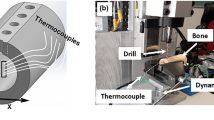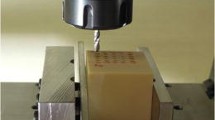For biocompatibility evaluation, orthopaedic and dental biomaterials are often implanted into bone after drilling. Bone repair in the drilled hole may be affected by bone damage attributed to drilling, thus influencing the bone response to biomaterials. The drilling parameters (the speed of rotation and irrigation) were investigated histologically. Three holes were drilled in each rabbit tibia with different conditions; three speeds (200, 500 and 5000 r.p.m.) and the use of central irrigation or not. Rabbits were killed immediately, 3 days, 2 weeks or 4 weeks post-operatively. India ink was injected in several rabbits just after drilling to investigate the extent of local ischaemia. The drilling quality was evaluated with regard to hole geometry, initial thermal damage and later bone healing process. For 500 or 200 r.p.m. the initial thermal damage, shown by the degree of ischaemia, was less than for 5000 r.p.m. drilling, but the hole edge was not always cleanly cut. This uneven cut edge was considered not to influence the bone-healing process. Drilling at 200 r.p.m. introduced a lower degree of circularity. The subsequent bone formation was retarded by 5000 r.p.m. drilling, presumably due to thermal damage and vascular obstructions. The irrigation was effective in reducing the ischaemic area. These results suggest that a speed of about 500 r.p.m. may be recommendable for intraosseous implantation of biomaterials. The central irrigation system is considered effective in reducing the ischaemic area.
Similar content being viewed by others
References
C. H. JACOBS, M. H. POPE, J. T. BERRY and F. T. HOAGLUND, J. Biomech. 7 (1974) 131.
C. H. JACOBS, J. T. BERRY, M. H. POPE and F. T. HOAGLUND, J. Biomech. 9 (1976) 343.
C. O. BECHTOL, A. B. FERGUSON and P.G. LAING, “Metals and Engineering in Bone and Joint Surgery” (Williams and Wilkins, Baltimore, 1959).
K. L. WIGGINS and S. MALKIN, J. Biomech. 9 (1976) 553.
J. A. HOBKIRK and K. RUSINIAK, J. Oral Surg. 35 (1977) 968.
H. C. THOMPSON, J. Oral Surg. 16 (1958) 22.
L. S. MATTHEWS and C. HIRSCH, J. Bone Joint Surg. 54A (1972) 297.
R. M. HALL, J. Oral Surg. 17 (1959) 3.
S. S. RAFEL, J. Oral Surg. 20 (1962) 475.
E. R. COSTICH, P. J. YOUNGBLOOD and J. M. WALDEN, Oral Surg. 17 (1964) 563.
R. W. MOSS, Oral Surg. 17 (1964) 405.
P. J. BOYNE, J. Dent. Res. 45 (1966) 270.
R. M. HALL, Oral Surg. 20 (1965) 150.
A. R. ERIKSSON, T. ALBREKTSSON and B. ALBREKTSSON, Acta Orthop. Scand. 55 (1984) 629.
J. LUNDSKOG, Scand. J. Plast. Reconstruct. Surg. 9 (Suppl No. 9) (1972) p. 11.
S. SEVITT, in “Bone Repair and Fracture Healing in Man” (Churchill Livingstone, London, 1981) p. 108.
Author information
Authors and Affiliations
Rights and permissions
About this article
Cite this article
Ohashi, H., Therin, M., Meunier, A. et al. The effect of drilling parameters on bone. J Mater Sci: Mater Med 5, 225–231 (1994). https://doi.org/10.1007/BF00121093
Received:
Accepted:
Issue Date:
DOI: https://doi.org/10.1007/BF00121093




